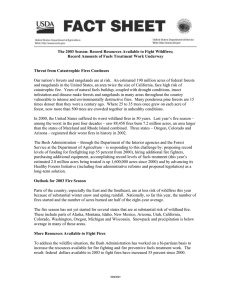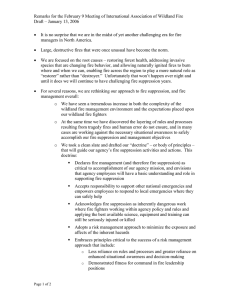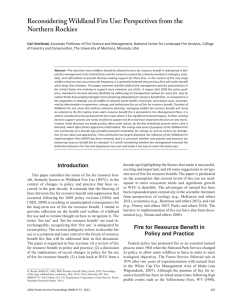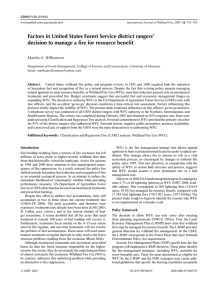Wildland Fire Use: The “Other” Treatment Option Fuels Planning: Science Synthesis and Integration
advertisement
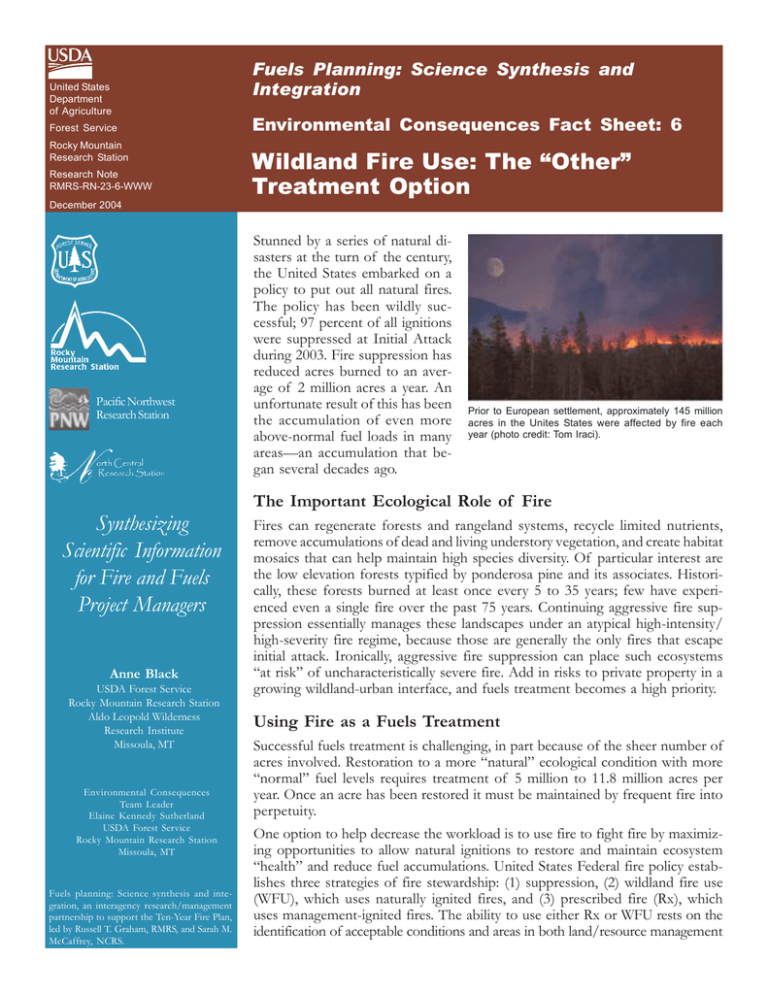
United States Department of Agriculture Forest Service Rocky Mountain Research Station Research Note RMRS-RN-23-6-WWW December 2004 Pacific Northwest Research Station Synthesizing Scientific Information for Fire and Fuels Project Managers Anne Black USDA Forest Service Rocky Mountain Research Station Aldo Leopold Wilderness Research Institute Missoula, MT Environmental Consequences Team Leader Elaine Kennedy Sutherland USDA Forest Service Rocky Mountain Research Station Missoula, MT Fuels planning: Science synthesis and integration, an interagency research/management partnership to support the Ten-Year Fire Plan, led by Russell T. Graham, RMRS, and Sarah M. McCaffrey, NCRS. Fuels Planning: Science Synthesis and Integration Environmental Consequences Fact Sheet: 6 Wildland Fire Use: The “Other” Treatment Option Stunned by a series of natural disasters at the turn of the century, the United States embarked on a policy to put out all natural fires. The policy has been wildly successful; 97 percent of all ignitions were suppressed at Initial Attack during 2003. Fire suppression has reduced acres burned to an average of 2 million acres a year. An unfortunate result of this has been the accumulation of even more above-normal fuel loads in many areas—an accumulation that began several decades ago. Prior to European settlement, approximately 145 million acres in the Unites States were affected by fire each year (photo credit: Tom Iraci). The Important Ecological Role of Fire Fires can regenerate forests and rangeland systems, recycle limited nutrients, remove accumulations of dead and living understory vegetation, and create habitat mosaics that can help maintain high species diversity. Of particular interest are the low elevation forests typified by ponderosa pine and its associates. Historically, these forests burned at least once every 5 to 35 years; few have experienced even a single fire over the past 75 years. Continuing aggressive fire suppression essentially manages these landscapes under an atypical high-intensity/ high-severity fire regime, because those are generally the only fires that escape initial attack. Ironically, aggressive fire suppression can place such ecosystems “at risk” of uncharacteristically severe fire. Add in risks to private property in a growing wildland-urban interface, and fuels treatment becomes a high priority. Using Fire as a Fuels Treatment Successful fuels treatment is challenging, in part because of the sheer number of acres involved. Restoration to a more “natural” ecological condition with more “normal” fuel levels requires treatment of 5 million to 11.8 million acres per year. Once an acre has been restored it must be maintained by frequent fire into perpetuity. One option to help decrease the workload is to use fire to fight fire by maximizing opportunities to allow natural ignitions to restore and maintain ecosystem “health” and reduce fuel accumulations. United States Federal fire policy establishes three strategies of fire stewardship: (1) suppression, (2) wildland fire use (WFU), which uses naturally ignited fires, and (3) prescribed fire (Rx), which uses management-ignited fires. The ability to use either Rx or WFU rests on the identification of acceptable conditions and areas in both land/resource management plans and fire management plans. Both Rx and WFU tactics can and do include active fire management where necessary, but WFU tactics are intended to be lighthanded and allow fire to play its natural role as much as possible. Benefits and Risks of Fire In terms of fuel reduction methods, one advantage of fire use (both Rx and WFU) is cost. Of the major fuels treatment classes—mechanical thinning, Rx, WFU—the latter two are the cheapest and most widely used. Nearly 77 percent of the 2 million acres treated under the National Fire Plan in fiscal year 2003 (October 1, 2002– September 30, 2003) were done with prescribed fire. Wildland fire use acres contributed an additional 331,000 acres in 2003 (up from a previous 5-year average of 67,000 acres annually). Costs are inverse; average fire use costs are an order of magnitude cheaper than either suppression or mechanical thinning. Between 1990 and 2002, average suppression costs for the nation calculated from total annual acres and total annual costs ran $500 per acre. By comparison, Rx and WFU costs averaged around $40 to $50 per acre. While there is high variability in costs of fire use and suppression—largely a function of values at risk—suppression is nearly always the most expensive option. Another advantage is fire’s ability to help managers meet land management goals and objectives. Using natural and management ignitions to our collective advantage requires a clear understanding of both the benefits and the risks of fire before the onset of the fire season. Benefits include the potential to move toward land management objectives as well as to accomplish fuels reduction and increase firefighter safety. Risks include both risks from a fire to human life and property, as well as risks from not applying fire, such as continued fuels accumulation, increased risk of future catastrophic wildfire, and the impact these may have on the ability to reach land management objectives. How can benefits and risks be assessed? One way is to map predicted behavior under typical fire weather conditions (such as 80, 90, 99 percentile Energy Release Component), identify how fire is likely to affect target resources, then compare the predicted outcome to land management targets. Taking full advantage of natural ignitions, where benefits are expected, can assist in meeting ecological and fiscal goals. Alternatively, Rx can assist where benefits exist but where natural ignitions are not feasible due to unacceptable consequences to values at risk in the area. More information on this process may be found at http://leopold.wilderness.net/research/fprojects/F001.htm. References Rx and WSFU fires are both managed to achieve predetermined goals (photo credit: Tom Iraci). Environmental Consequences Fact Sheets Look for fact sheet topics from the Environmental Consequences Team including information about the effects of fire behavior and alternative treatment strategies, Wildlife Response Model, weed responses, riparian systems, soil erosion, restoration objectives, treated spaces, the Fire Effects Information System (FEIS), and the First Order Fire Effects Model (FOFEM). National Interagency Coordination Center. [n.d.]. 2001, 2002, and 2003 summary statistics. Available: http:// www.nifc.gov/news/nicc.html. [December 01, 2004]. Schmidt K. M.; Menakis, J. P.; Hardy, C. C.; Hann, W. J.; Bunnell, D. L. 2002. Development of coarse-scale spatial data for wildland fire and fuel management. Gen. Tech. Rep. GTR-RMRS-87. Fort Collins, CO: U.S. Department of Agriculture, Forest Service, Rocky Mountain Research Station. 41 p. Fuels Planning: Synthesis and Integration This fact sheet is one in a series being produced as part of a larger project supported by the USDA Forest Service to synthesize new knowledge and information relevant to fire and fuels management. Fact sheets address topics related to stand structure, environmental impacts, economics, and human responses to these factors. Information in the fact sheets is targeted for the dry forests of the Inland West, but is often applicable across broad regions of the country. For more information, please visit our Web site at: www.fs.fed.us/fire/tech_transfer/synthesis/synthesis_index The Fuels Planning fact sheets are based on preliminary findings. Information from fact sheets will be synthesized in an upcoming publication.

